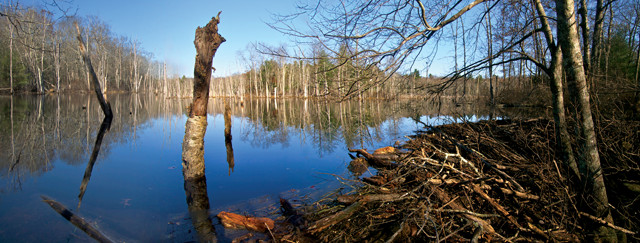
by Mary Caperton Morton Monday, March 9, 2015

Ponds and wetlands created by beaver dams, like this one in Rhode Island, may produce significant amounts of methane. Credit: Mary Caperton Morton.
Beavers were nearly killed off in the 19th century as trappers hunted them for their soft pelts. A successful conservation effort over the past 100 years brought the dam-builders back from the brink, but a new study published in the journal AMBIO has found that all those beaver-built ponds may be producing significant amounts of methane, a greenhouse gas.
Beavers build dams in streams and rivers, creating ponds and wetlands with standing water. As plants and other organic matter build up at the bottom of these ponds, methane is produced and released into the atmosphere. To quantify the beavers’ methane contribution, Colin Whitfield of the University of Saskatchewan in Canada and colleagues estimated the size of the current global beaver population and the area covered by beaver ponds.
They found that the global population, including North American and Eurasian species, totals more than 10 million animals, which together dam more than 42,000 square kilometers of ponds and more than 200,000 square kilometers of wetlands. All that standing water contributes up to 0.8 metric tons of methane to the atmosphere each year. The beavers’ tally, however, is just a fraction compared to emissions from the global population of domestic livestock such as cows and sheep, which produce more than 80 million metric tons of methane annually.
“The dynamic nature of beaver-mediated methane emissions in recent years may portend the potential for future changes in this component of the global methane budget,” Whitfield and colleagues wrote. “Continued range expansion, coupled with changes in population and pond densities, may dramatically increase the amount of water impounded by the beaver … and the contribution of beaver activity to global [methane] emissions may continue to grow.”
© 2008-2021. All rights reserved. Any copying, redistribution or retransmission of any of the contents of this service without the expressed written permission of the American Geosciences Institute is expressly prohibited. Click here for all copyright requests.